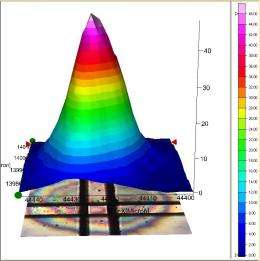Diamond synchrotron set to develop new ways to detect cancer

(PhysOrg.com) -- Diamond Light Source, the UK's synchrotron science facility, is being used by a Stoke-on-Trent based clinician to develop new ways to detect cancer.
Located in south Oxfordshire, the Diamond synchrotron’s new infrared facility is helping researchers to identify, at single cell level, biomarkers in cancer cells to distinguish healthy cells from cancerous ones. The outcome could be quicker cancer detection meaning starting treatment earlier and a reduction in health service costs.
Dr Josep Sulé-Suso, an oncologist specialising in lung cancer based at the new Cancer Centre at the University Hospital of North Staffordshire, and at the Guy Hilton Research Centre, Keele University, is the lead researcher on the project. He says,
“One in three people will develop some form of cancer during their lifetime and research has shown that survival rates are higher the earlier the cancer is diagnosed. One of the problems faced by pathologists when trying to diagnose cancer is the presence of abnormal cells in biopsy samples. This is when the patient’s biopsy contains cells that are not normal but can neither be confirmed as cancer. The patient will have already undergone a biopsy, which carries side effects and risks, and will have to face further biopsies for the pathologist to be able to confirm whether the patient has cancer or not, delaying the treatment and increasing the costs to the health service.”
Along with his fellow researchers and the team of Diamond scientists at the B22 Infrared beamline lead by Dr Gianfelice Cinque, Dr Sulé-Suso has just published a paper in the journal Laboratory Investigation describing how synchrotron-based infrared technique can be used to aid cancer diagnosis using stained samples. In December 2009, Dr Sulé-Suso became the first researcher to use the new infrared capabilities at Diamond Light Source.
Known for producing extremely intense pinpoint beams of X-rays to look at the atomic and molecular details of samples from virtually any field of science, synchrotrons can also be used to carry out high-resolution studies using infrared light; revealing the secrets of all manner of objects, from human cells to the hidden works behind famous paintings such as those of van Gogh, usually invisible to the naked eye. Although work like this has not yet taken place on the Infrared beamline at Diamond, due to it being in the early stages of operation, the potential of this brand new facility is huge.
The successful pilot study led by Dr Sulé-Suso looks right inside cells - both lung cancer cells and normal cells - in tissue samples taken from around 50 lung cancer patients. Dr Sulé-Suso and the team are looking for markers in the cancer cells - differences in for example the fat content, protein or DNA. The Diamond synchrotron enables them to look further and in the future diagnose cancer at single cell level, thereby helping pathologists in the diagnosis of cancer from difficult samples.
Dr Sulé-Suso adds, “Identifying cancer cells in this way will be better all round. If we can better characterise the abnormal cells without further biopsies, we will reduce the number of biopsies thus reducing risks and side effects for patients, starting treatment earlier, and reducing costs for the NHS.
The next stage of this research is to widen and expand the studies involving a much larger number of lung cancer patients. Once the markers have been identified and the preliminary work has been confirmed, this research will make it easier to study abnormal cells using equipment available in a pathology lab to confirm whether they are cancerous.
Provided by Diamond Light Source

















